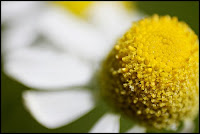I use both the Roman and Maroc variations of essential oil in my aromatherapy practice but favour the Roman version more so as it has a nicer aroma. I haven’t used German Chamomile at all, although after researching this post I think I might purchase one as it has many useful properties that the other two variations do not.
German Chamomile has a dark blue appearance due to its azulene content. Azulene is a powerful anti-inflammatory which is why German chamomile is a more effective anti-inflammatory than Roman chamomile, although it is still helpful for this.
German Chamomile is very effective at treating skin conditions, whereas Roman chamomile is better suited to calming a person.
Chamomile Maroc is not recognised as a true chamomile according to Shirley Price, author of the Aromatherapy Workbook: Understanding Essential Oils - From Plant to Bottle
“to emulate many of the effects attributed to its aristocratic relation”– German and Roman chamomile.
Below is a table comparing the properties of all three chamomile essential oils.
| Property | German Chamomile | Chamomile Maroc | Roman Chamomile |
| Analgesic | Y | Y | |
| Anti-allergic | Y | ||
| Anti-bacterial | Y | Y | |
| Anti-depressant | Y | Y | |
| Anti-infectious | Y | ||
| Anti-inflammatory | Y | Y | |
| Anti-spasmodic | Y | Y | Y |
| Calming | Y | ||
| Carminative | Y | ||
| Cicatrizant | Y | Y | |
| Chologogic | Y | ||
| Decongestant | Y | ||
| Digestive | Y | ||
| Diuretic | Y | ||
| Emmenagogue | Y | Y | |
| Febrifuge | Y | ||
| Hormonal | Y | ||
| Neurotonic | Y | ||
| Relaxant | Y | Y | |
| Sedative | Y | Y | |
| Vulnary | Y | Y |


![Reblog this post [with Zemanta]](http://img.zemanta.com/reblog_e.png?x-id=df66ffbf-064c-49b4-a083-5d95207673d8)






No comments:
Post a Comment